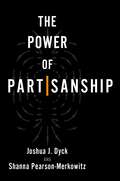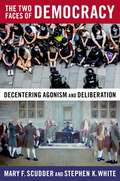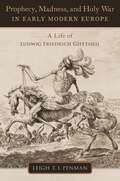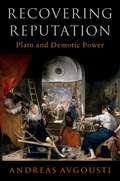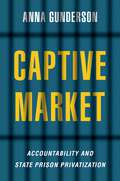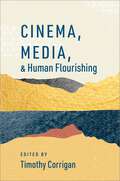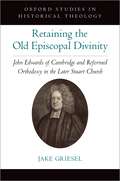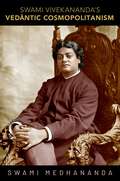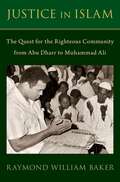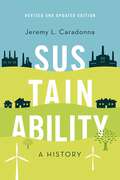- Table View
- List View
The Power of Partisanship
by Joshua J. Dyck Shanna Pearson-MerkowitzIn The Power of Partisanship, Joshua J. Dyck and Shanna Pearson-Merkowitz argue that the growth in partisan polarization in the United States, and the resulting negativity voters feel towards their respective opposition party, has far-reaching effects on how Americans behave both inside and outside the realm of politics. In fact, no area of social life in the United States is safe from partisan influence. As a result of changes in the media landscape and decades of political polarization, voters are stronger partisans than in the past and are more likely to view the opposition party with a combination of confusion, disdain, and outright hostility. Yet, little of this hostility is grounded in specific policy preferences. Even ideology lacks meaning in the United States: conservative and liberal are what Republicans and Democrats have labeled "conservative" and "liberal." Dyck and Pearson-Merkowitz show how partisanship influences the electorate's support for democratic norms, willingness to engage in risk related to financial and healthcare decisions, interracial interactions, and previously non-political decisions like what we like to eat for dinner. Partisanship prevents people from learning from their interactions with friends or the realities of their neighborhoods, and even makes them oblivious to their own economic hardship. The intensity and pervasiveness of partisanship in politics today has resulted in "political knowledge" becoming an endogenous feature of strong partisanship and a poor proxy for anything but partisan behavior. Dyck and Pearson-Merkowitz present evidence that pure independents are, in fact, very responsive to information because they are not biased by partisan elite cues and important and relevant political information is often local, contextual, and personal. Drawing on a series of original surveys and experiments conducted between 2014 and 2020, Dyck and Pearson-Merkowitz show how the dominance of partisanship as a decision cue has fundamentally transformed our understanding of both political and non-political behavior.
The Buddhist Tantras: A Guide (Guides to Sacred Texts)
by David B. GrayThe tantric Buddhist traditions emerged in India beginning in the seventh century CE and flourished there until the demise of Buddhism in India circa the fifteenth century. These traditions were disseminated to Central, East, and Southeast Asia, and continue to be practiced, most notably in Nepal, Tibet and Japan, as well as in the numerous Tibetan traditions disseminated around the world by Tibetan masters living in diaspora. The central scriptures for these traditions were generally designated by the term tantra. Tantras are works that purport to relate secret teachings of the buddhas that enable awakening in as short as one lifetime. As such they are understood by their advocates to be the inspired speech of a buddha, and hence worthy of inclusion in the canons of Buddhist traditions. Over the past twenty years there has been considerable growth in the study of tantras as well as translations of these works into Western languages. This volume provides a detailed introduction to the Buddhist tantras. It addresses their development in India, their dissemination to Central, East and Southeast Asia, and their reception in these contexts. It introduces the key teachings in the tantras, as well as the history of their interpretation, and their connection to traditions of ritual, and contemplative practices. It also introduces the classification of the tantras and their place in Buddhist scriptural canons. It concludes with a look at the transgressive rhetoric that characterizes many of the tantras, the impact this had on their dissemination and translation, and the ways in which Buddhists explained this. It suggests that transgressive rhetoric and practices served an important role in Buddhist tantric traditions, which may be why they persist despite the challenges they have presented to the dissemination of these traditions.
The Buddhist Tantras: A Guide (Guides to Sacred Texts)
by David B. GrayThe tantric Buddhist traditions emerged in India beginning in the seventh century CE and flourished there until the demise of Buddhism in India circa the fifteenth century. These traditions were disseminated to Central, East, and Southeast Asia, and continue to be practiced, most notably in Nepal, Tibet and Japan, as well as in the numerous Tibetan traditions disseminated around the world by Tibetan masters living in diaspora. The central scriptures for these traditions were generally designated by the term tantra. Tantras are works that purport to relate secret teachings of the buddhas that enable awakening in as short as one lifetime. As such they are understood by their advocates to be the inspired speech of a buddha, and hence worthy of inclusion in the canons of Buddhist traditions. Over the past twenty years there has been considerable growth in the study of tantras as well as translations of these works into Western languages. This volume provides a detailed introduction to the Buddhist tantras. It addresses their development in India, their dissemination to Central, East and Southeast Asia, and their reception in these contexts. It introduces the key teachings in the tantras, as well as the history of their interpretation, and their connection to traditions of ritual, and contemplative practices. It also introduces the classification of the tantras and their place in Buddhist scriptural canons. It concludes with a look at the transgressive rhetoric that characterizes many of the tantras, the impact this had on their dissemination and translation, and the ways in which Buddhists explained this. It suggests that transgressive rhetoric and practices served an important role in Buddhist tantric traditions, which may be why they persist despite the challenges they have presented to the dissemination of these traditions.
The Two Faces of Democracy: Decentering Agonism and Deliberation
by Mary F. Scudder Stephen K. WhiteThe democratic imagination is facing significant challenges. These challenges involve not only philosophical questions about the core values of democratic life, but also pressing practical issues related to how we should understand and confront current threats to democracy. Those who want to defend democracy against anti-democratic forces are at odds: some want a politics that puts vehement conflict at the center of democratic strategies, while others assert the necessity of more civil and deliberative strategies. What should our stance be as defenders of democratic life? In The Two Faces of Democracy, Mary F. (Molly) Scudder and Stephen K. White present an analysis of these two stances, the deliberative and agonistic models of democracy, arguing that neither is adequate on its own. The deliberative model emphasizes reasoned discussion, but some worry that this discounts structures of injustice that distort civil deliberation. The agonistic model prioritizes contestation and conflict, but this prime orientation to defeating political antagonists risks corroding our commitment to normative democratic restraints, like fairness. In developing an understanding of the moral core of democracy, Scudder and White show that these two faces of democratic life each have a significant, but constrained, role to play in a more capacious comprehension of what our democratic commitments require of us. An original and timely contribution to democratic theory, Scudder and White illuminate the tensional congruence of these two faces of democracy, and, in doing so, argue for the importance of both models in the current struggle for a healthy democratic future.
The Two Faces of Democracy: Decentering Agonism and Deliberation
by Mary F. Scudder Stephen K. WhiteThe democratic imagination is facing significant challenges. These challenges involve not only philosophical questions about the core values of democratic life, but also pressing practical issues related to how we should understand and confront current threats to democracy. Those who want to defend democracy against anti-democratic forces are at odds: some want a politics that puts vehement conflict at the center of democratic strategies, while others assert the necessity of more civil and deliberative strategies. What should our stance be as defenders of democratic life? In The Two Faces of Democracy, Mary F. (Molly) Scudder and Stephen K. White present an analysis of these two stances, the deliberative and agonistic models of democracy, arguing that neither is adequate on its own. The deliberative model emphasizes reasoned discussion, but some worry that this discounts structures of injustice that distort civil deliberation. The agonistic model prioritizes contestation and conflict, but this prime orientation to defeating political antagonists risks corroding our commitment to normative democratic restraints, like fairness. In developing an understanding of the moral core of democracy, Scudder and White show that these two faces of democratic life each have a significant, but constrained, role to play in a more capacious comprehension of what our democratic commitments require of us. An original and timely contribution to democratic theory, Scudder and White illuminate the tensional congruence of these two faces of democracy, and, in doing so, argue for the importance of both models in the current struggle for a healthy democratic future.
Prophecy, Madness, and Holy War in Early Modern Europe: A Life of Ludwig Friedrich Gifftheil (OXFORD STU WESTERN ESOTERICISM SERIES)
by Leigh T.I. PenmanThe political and religious turmoil of seventeenth century Europe appears in a strange new light in this volume, which explores the life and doctrines of the infamous German barber surgeon and prophet, Ludwig Friedrich Gifftheil (1595-1661). Inspired by an unstable alchemy of family tragedy and a corpus of dissenting religious writings, Gifftheil stalked Europe's battlefields, petitioning kings, princes, and emperors to end the warfare endemic on the continent. Convinced that all war was prompted by 'false prophets'--by which Gifftheil meant the clergy of Europe's Christian confessions--he pleaded with rulers to abjure the counsel of their advisors and institute instead a godly peace. Then, in 1635, Gifftheil reinvented himself by taking up his sword as "God's warrior," embarking on a quest to recruit an army of the righteous and wage a holy war in Europe and to institute a divine peace. Prophecy, Madness, and Holy War in Early Modern Europe uses new manuscript and print sources from across Europe, the United Kingdom, and North America to craft the definitive account of Gifftheil's life and exploits. Against a background of family loss, and restless travels across the continent, Gifftheil's story reveals an alternative history of religious and political dissent in the seventeenth century. His adventures cast a dramatic new light on the culture and society of early modernity, the place of prophecy and madness in the negotiation of religious authority, the origins of the theosophical current, and the stranger apocalyptic impulses at the roots of Pietism and missionary Christianity.
Prophecy, Madness, and Holy War in Early Modern Europe: A Life of Ludwig Friedrich Gifftheil (OXFORD STU WESTERN ESOTERICISM SERIES)
by Leigh T.I. PenmanThe political and religious turmoil of seventeenth century Europe appears in a strange new light in this volume, which explores the life and doctrines of the infamous German barber surgeon and prophet, Ludwig Friedrich Gifftheil (1595-1661). Inspired by an unstable alchemy of family tragedy and a corpus of dissenting religious writings, Gifftheil stalked Europe's battlefields, petitioning kings, princes, and emperors to end the warfare endemic on the continent. Convinced that all war was prompted by 'false prophets'--by which Gifftheil meant the clergy of Europe's Christian confessions--he pleaded with rulers to abjure the counsel of their advisors and institute instead a godly peace. Then, in 1635, Gifftheil reinvented himself by taking up his sword as "God's warrior," embarking on a quest to recruit an army of the righteous and wage a holy war in Europe and to institute a divine peace. Prophecy, Madness, and Holy War in Early Modern Europe uses new manuscript and print sources from across Europe, the United Kingdom, and North America to craft the definitive account of Gifftheil's life and exploits. Against a background of family loss, and restless travels across the continent, Gifftheil's story reveals an alternative history of religious and political dissent in the seventeenth century. His adventures cast a dramatic new light on the culture and society of early modernity, the place of prophecy and madness in the negotiation of religious authority, the origins of the theosophical current, and the stranger apocalyptic impulses at the roots of Pietism and missionary Christianity.
Emergency Psychiatry (PRIMER ON SERIES)
by Tony ThrasherPsychiatric emergencies are encountered throughout the practice of medicine, in many clinical settings. They may range from a patient expressing suicidal thoughts in an outpatient medical visit to an agitated, threatening patient with psychosis who is acutely intoxicated brought to the Emergency Department by ambulance. Decisions regarding admission, discharge, treatment, and referral are time-sensitive in the emergency setting or when acute safety issues are at stake. A broad knowledge of psychiatry and an understanding of potential medical etiologies of behavioral changes are important, as well as skills navigating what can be a complicated consultation relationship with the emergency department and challenging systems-based issues. In a time when emergency department visits continue to grow, resources for inpatient beds remain scarce and outpatient care can be difficult to access, the demand for psychiatric care and evaluation in the emergency setting is crucial. This volume, the 12th in the Primer On series, provides a straightforward approach to evaluating and managing common psychiatric emergencies. Blending case examples with up-to-date evidence-based approaches, this book serves as both a reference and introductory text for clinicians who are working in an emergency department or emergency consult setting.
Emergency Psychiatry (PRIMER ON SERIES)
by Tony ThrasherPsychiatric emergencies are encountered throughout the practice of medicine, in many clinical settings. They may range from a patient expressing suicidal thoughts in an outpatient medical visit to an agitated, threatening patient with psychosis who is acutely intoxicated brought to the Emergency Department by ambulance. Decisions regarding admission, discharge, treatment, and referral are time-sensitive in the emergency setting or when acute safety issues are at stake. A broad knowledge of psychiatry and an understanding of potential medical etiologies of behavioral changes are important, as well as skills navigating what can be a complicated consultation relationship with the emergency department and challenging systems-based issues. In a time when emergency department visits continue to grow, resources for inpatient beds remain scarce and outpatient care can be difficult to access, the demand for psychiatric care and evaluation in the emergency setting is crucial. This volume, the 12th in the Primer On series, provides a straightforward approach to evaluating and managing common psychiatric emergencies. Blending case examples with up-to-date evidence-based approaches, this book serves as both a reference and introductory text for clinicians who are working in an emergency department or emergency consult setting.
Recovering Reputation: Plato and Demotic Power
by Andreas AvgoustiDemocratic societies run on opinion, and so reputation matters to their functioning. Issues pertaining to reptuation emerge in discussions ranging from the character of political candidates to the image nation-states project to domestic and foreign audiences. But reputation is also a cause of concern. We worry that political appearances are highly artificial, stage-managed affairs; that politicians merely pretend to care about their constituents; and that the rhetoric of "people power" is mere window-dressing for what is, in fact, rule by elites. In short, we tend to think of reputation as the business of the few, rather than the many. In Recovering Reputation, Andreas Avgousti considers the modern problem of reputation by turning to the dialogues of Plato, to demonstrate that reputation is not only an issue for political elites, but that it is a quality that helps the wider citizenry to cohere, bringing together citizens and non-citizens. Plato shows elites, both citizens and non-citizens, engaging non-elites either by undermining their opinion or by challenging it. But when elites in Plato's writings challenge (rather than merely undermine) popular opinion they still seek their public's praise. Avgousti argues that reputation is worth thinking about because it is a power that circulates among the many, linked to and sustained by myths and rumors, and it is a power that the many exercise through the social mechanisms of praise and blame. In this way, Avgousti illustrates that reputation is something that can destabilize normative ideas while still being a powerful force in our democratic politics. In working through Plato's writings, Recovering Reputation expands our understandings of reputation's potential in democratic contexts.
Recovering Reputation: Plato and Demotic Power
by Andreas AvgoustiDemocratic societies run on opinion, and so reputation matters to their functioning. Issues pertaining to reptuation emerge in discussions ranging from the character of political candidates to the image nation-states project to domestic and foreign audiences. But reputation is also a cause of concern. We worry that political appearances are highly artificial, stage-managed affairs; that politicians merely pretend to care about their constituents; and that the rhetoric of "people power" is mere window-dressing for what is, in fact, rule by elites. In short, we tend to think of reputation as the business of the few, rather than the many. In Recovering Reputation, Andreas Avgousti considers the modern problem of reputation by turning to the dialogues of Plato, to demonstrate that reputation is not only an issue for political elites, but that it is a quality that helps the wider citizenry to cohere, bringing together citizens and non-citizens. Plato shows elites, both citizens and non-citizens, engaging non-elites either by undermining their opinion or by challenging it. But when elites in Plato's writings challenge (rather than merely undermine) popular opinion they still seek their public's praise. Avgousti argues that reputation is worth thinking about because it is a power that circulates among the many, linked to and sustained by myths and rumors, and it is a power that the many exercise through the social mechanisms of praise and blame. In this way, Avgousti illustrates that reputation is something that can destabilize normative ideas while still being a powerful force in our democratic politics. In working through Plato's writings, Recovering Reputation expands our understandings of reputation's potential in democratic contexts.
Captive Market: The Politics of Private Prisons in America (Studies in Postwar American Political Development)
by Anna GundersonA novel explanation for state prison privatization: that they do so to limit legal and political accountability for inmate lawsuits. One of the most controversial developments in the American criminal justice in the last few decades has been the development of the modern private prison industry. While there are many explanations proffered for the adoption of this policy--including partisanship, economic stress, unionization, and lobbying efforts by private prison firms--none fully explain why states privatize their prisons. In Captive Market, Anna Gunderson proposes a novel explanation for why states adopt this policy. She shows that states privatize prisons to limit legal and political accountability for inmate lawsuits, an unintended consequence of the legal rights revolution for prisoners. Evidence from an original dataset and interviews with private prison companies, government officials, and advocacy groups suggest that growing prisoner lawsuits are a significant driver of prison privatization in the United States. With over 160,000 inmates currently held in private facilities across the country, it is vital to understand the causes of this rise and the nuances of private prison policy, one with significant consequences for the American criminal legal system. An eye-opening account of an industry that many are aware of but few know much about, this book will reshape our understanding of the fundamental nature of the American carceral state.
Captive Market: The Politics of Private Prisons in America (Studies in Postwar American Political Development)
by Anna GundersonA novel explanation for state prison privatization: that they do so to limit legal and political accountability for inmate lawsuits. One of the most controversial developments in the American criminal justice in the last few decades has been the development of the modern private prison industry. While there are many explanations proffered for the adoption of this policy--including partisanship, economic stress, unionization, and lobbying efforts by private prison firms--none fully explain why states privatize their prisons. In Captive Market, Anna Gunderson proposes a novel explanation for why states adopt this policy. She shows that states privatize prisons to limit legal and political accountability for inmate lawsuits, an unintended consequence of the legal rights revolution for prisoners. Evidence from an original dataset and interviews with private prison companies, government officials, and advocacy groups suggest that growing prisoner lawsuits are a significant driver of prison privatization in the United States. With over 160,000 inmates currently held in private facilities across the country, it is vital to understand the causes of this rise and the nuances of private prison policy, one with significant consequences for the American criminal legal system. An eye-opening account of an industry that many are aware of but few know much about, this book will reshape our understanding of the fundamental nature of the American carceral state.
Cinema, Media, and Human Flourishing (The Humanities and Human Flourishing)
by Timothy CorriganThe Humanities and Human Flourishing series publishes edited volumes that explore the role of human flourishing in the central disciplines of the humanities, and whether and how the humanities can increase human happiness. This edited volume examines the role of cinema and media in the context of human flourishing. The history of cinema is rife with films and genres in which positive cinematic narratives stand out as remarkable and defining achievements. Since the 1930s through the superhero movies of today, from You Can't Take It with You or Toy Story to literary adaptations like Midsummer Night's Dream or Clueless, films have celebrated the resilience and triumphs of people pursuing a life of happiness and contentment. Yet, in the majority of these films, various crises shadow these pursuits, adding obstacles and detours that suggest films require a narrative drama of conflict, out of which human well-being and flourishing eventually emerge. This volume covers a multitude of historical periods and topics, including discussions of the Aristotelian and classical models of a "good life" that inform animated fairy tales today; how 1930s French and Hollywood films responded to the dire need for productive human relationships in a turbulent decade; the polemical positions of black film criticism through the lens of James Baldwin; a discussion of contemporary filmic quests for happiness; the challenges for women filmmakers today in mapping the values of their own world; the scientific, psychological, and philosophical base for human value; and the shifting media frames of modern society and selves. Cinema, Media Studies, and Human Flourishing features a diverse array of approaches to understanding human flourishing through cinematic representations of the journey to a fulfilling life.
Cinema, Media, and Human Flourishing (The Humanities and Human Flourishing)
by Timothy CorriganThe Humanities and Human Flourishing series publishes edited volumes that explore the role of human flourishing in the central disciplines of the humanities, and whether and how the humanities can increase human happiness. This edited volume examines the role of cinema and media in the context of human flourishing. The history of cinema is rife with films and genres in which positive cinematic narratives stand out as remarkable and defining achievements. Since the 1930s through the superhero movies of today, from You Can't Take It with You or Toy Story to literary adaptations like Midsummer Night's Dream or Clueless, films have celebrated the resilience and triumphs of people pursuing a life of happiness and contentment. Yet, in the majority of these films, various crises shadow these pursuits, adding obstacles and detours that suggest films require a narrative drama of conflict, out of which human well-being and flourishing eventually emerge. This volume covers a multitude of historical periods and topics, including discussions of the Aristotelian and classical models of a "good life" that inform animated fairy tales today; how 1930s French and Hollywood films responded to the dire need for productive human relationships in a turbulent decade; the polemical positions of black film criticism through the lens of James Baldwin; a discussion of contemporary filmic quests for happiness; the challenges for women filmmakers today in mapping the values of their own world; the scientific, psychological, and philosophical base for human value; and the shifting media frames of modern society and selves. Cinema, Media Studies, and Human Flourishing features a diverse array of approaches to understanding human flourishing through cinematic representations of the journey to a fulfilling life.
Retaining the Old Episcopal Divinity: John Edwards of Cambridge and Reformed Orthodoxy in the Later Stuart Church (Oxford Studies in Historical Theology)
by Jake GrieselJohn Edwards of Cambridge (1637-1716) has typically been portrayed as a marginalized 'Calvinist' in an overwhelmingly 'Arminian' later Stuart Church of England. In Retaining the Old Episcopal Divinity, Jake Griesel challenges this depiction of Edwards and the theological climate of his contemporary Church. Griesel demonstrates that Edwards was recognized in his own day and the immediately following generations as one of the preeminent conforming divines of the period, who featured prominently in notable theological controversies involving contemporaries such as John Locke, Gilbert Burnet, Daniel Whitby, William Whiston, and Samuel Clarke. Despite some Arminian opposition, Edwards' theological works are shown to have enjoyed a warm reception among sizable segments of the established Church's clergy, many of whom shared his Reformed convictions. The analysis shows that, instead of a theological misfit, the anti-Arminian Edwards was a decidedly mainstream churchman. Griesel's reassessment has ramifications far beyond the figure of Edwards and ultimately serves as a prism through which to visualize with much greater clarity the broader theological landscape of the later Stuart Church of England, and particularly the place of Reformed orthodoxy within it. Retaining the Old Episcopal Divinity develops recent research on the persisting vitality of Reformed theology within the post-Restoration Church, demonstrating the strength and numbers of conforming Reformed divines between the Restoration and the evangelical revivals.
Retaining the Old Episcopal Divinity: John Edwards of Cambridge and Reformed Orthodoxy in the Later Stuart Church (Oxford Studies in Historical Theology)
by Jake GrieselJohn Edwards of Cambridge (1637-1716) has typically been portrayed as a marginalized 'Calvinist' in an overwhelmingly 'Arminian' later Stuart Church of England. In Retaining the Old Episcopal Divinity, Jake Griesel challenges this depiction of Edwards and the theological climate of his contemporary Church. Griesel demonstrates that Edwards was recognized in his own day and the immediately following generations as one of the preeminent conforming divines of the period, who featured prominently in notable theological controversies involving contemporaries such as John Locke, Gilbert Burnet, Daniel Whitby, William Whiston, and Samuel Clarke. Despite some Arminian opposition, Edwards' theological works are shown to have enjoyed a warm reception among sizable segments of the established Church's clergy, many of whom shared his Reformed convictions. The analysis shows that, instead of a theological misfit, the anti-Arminian Edwards was a decidedly mainstream churchman. Griesel's reassessment has ramifications far beyond the figure of Edwards and ultimately serves as a prism through which to visualize with much greater clarity the broader theological landscape of the later Stuart Church of England, and particularly the place of Reformed orthodoxy within it. Retaining the Old Episcopal Divinity develops recent research on the persisting vitality of Reformed theology within the post-Restoration Church, demonstrating the strength and numbers of conforming Reformed divines between the Restoration and the evangelical revivals.
Swami Vivekananda's Ved=antic Cosmopolitanism
by Swami MedhanandaSwami Vivekananda, the nineteenth-century Hindu monk who introduced Vedanta to the West, is undoubtedly one of modern India's most influential philosophers. Unfortunately, his philosophy has too often been interpreted through reductive hermeneutic lenses. Typically, scholars have viewed him either as a modern-day exponent of Sankara's Advaita Vedanta or as a "Neo-Vedantin" influenced more by Western ideas than indigenous Indian traditions. In Swami Vivekananda's Ved=antic Cosmopolitanism, Swami Medhananda rejects these prevailing approaches to offer a new interpretation of Vivekananda's philosophy, highlighting its originality, contemporary relevance, and cross-cultural significance. Vivekananda, the book argues, is best understood as a cosmopolitan Vedantin who developed novel philosophical positions through creative dialectical engagement with both Indian and Western thinkers. Inspired by his guru Sri Ramakrishna, Vivekananda reconceived Advaita Vedanta as a nonsectarian, life-affirming philosophy that provides an ontological basis for religious cosmopolitanism and a spiritual ethics of social service. He defended the scientific credentials of religion while criticizing the climate of scientism beginning to develop in the late nineteenth century. He was also one of the first philosophers to defend the evidential value of supersensuous perception on the basis of general epistemic principles. Finally, he adopted innovative cosmopolitan approaches to long-standing philosophical problems. Bringing him into dialogue with numerous philosophers past and present, Medhananda demonstrates the sophistication and enduring value of Vivekananda's views on the limits of reason, the dynamics of religious faith, and the hard problem of consciousness.
Swami Vivekananda's Ved=antic Cosmopolitanism
by Swami MedhanandaSwami Vivekananda, the nineteenth-century Hindu monk who introduced Vedanta to the West, is undoubtedly one of modern India's most influential philosophers. Unfortunately, his philosophy has too often been interpreted through reductive hermeneutic lenses. Typically, scholars have viewed him either as a modern-day exponent of Sankara's Advaita Vedanta or as a "Neo-Vedantin" influenced more by Western ideas than indigenous Indian traditions. In Swami Vivekananda's Ved=antic Cosmopolitanism, Swami Medhananda rejects these prevailing approaches to offer a new interpretation of Vivekananda's philosophy, highlighting its originality, contemporary relevance, and cross-cultural significance. Vivekananda, the book argues, is best understood as a cosmopolitan Vedantin who developed novel philosophical positions through creative dialectical engagement with both Indian and Western thinkers. Inspired by his guru Sri Ramakrishna, Vivekananda reconceived Advaita Vedanta as a nonsectarian, life-affirming philosophy that provides an ontological basis for religious cosmopolitanism and a spiritual ethics of social service. He defended the scientific credentials of religion while criticizing the climate of scientism beginning to develop in the late nineteenth century. He was also one of the first philosophers to defend the evidential value of supersensuous perception on the basis of general epistemic principles. Finally, he adopted innovative cosmopolitan approaches to long-standing philosophical problems. Bringing him into dialogue with numerous philosophers past and present, Medhananda demonstrates the sophistication and enduring value of Vivekananda's views on the limits of reason, the dynamics of religious faith, and the hard problem of consciousness.
Hollywood Sports Movies and the American Dream
by Grant WiedenfeldThrough the heart of Hollywood cinema runs an unexpected current of progressive politics. Sports movies, a genre that has flourished since the mid-seventies, evoke the American dream and therefore represent the nation to itself in idealized form. Once considered mere credos for Reaganism's fantasies of an atomized society, movies from Rocky (1976) to Ali (2001) dream of democratic participation and recognition more than individual success, for in every case, off-field relationships take precedence over on-field competition. Arranged chronologically, Hollywood Sports Films and the American Dream is a critical study of six major sports films that re-tells the story of multiculturalism's gradual adoption in the latter third of the 20th century and rewrites contemporary understandings of the sports film. For author Grant Wiedenfeld, the mainstream's first minority heroes are paradoxically white ethnic, rural, working-class men, exemplified by Rocky, Slap Shot (1977) and The Natural (1984) and Black, brown, and women characters follow in White Men Can't Jump (1992), A League of Their Own (1992), and Ali. But despite their insistence on community and diversity these popular dramas show limited faith in civic institutions and point to the limits of inclusion and participation in the post-Civil Rights era. Hannah Arendt, Jeffrey Alexander, and others inform Wiedenfeld's original analysis and commentary on the political significance of popular culture as he insists on the cinema's capabilities as an engine for democracy untethered from more conventional 'democratic' institutions. Reading these familiar movies from another angle paints a fresh picture of how the United States has imagined democracy since its bicentennial and renews the political efficacy of one of the most popular genres in film history.
Hollywood Sports Movies and the American Dream
by Grant WiedenfeldThrough the heart of Hollywood cinema runs an unexpected current of progressive politics. Sports movies, a genre that has flourished since the mid-seventies, evoke the American dream and therefore represent the nation to itself in idealized form. Once considered mere credos for Reaganism's fantasies of an atomized society, movies from Rocky (1976) to Ali (2001) dream of democratic participation and recognition more than individual success, for in every case, off-field relationships take precedence over on-field competition. Arranged chronologically, Hollywood Sports Films and the American Dream is a critical study of six major sports films that re-tells the story of multiculturalism's gradual adoption in the latter third of the 20th century and rewrites contemporary understandings of the sports film. For author Grant Wiedenfeld, the mainstream's first minority heroes are paradoxically white ethnic, rural, working-class men, exemplified by Rocky, Slap Shot (1977) and The Natural (1984) and Black, brown, and women characters follow in White Men Can't Jump (1992), A League of Their Own (1992), and Ali. But despite their insistence on community and diversity these popular dramas show limited faith in civic institutions and point to the limits of inclusion and participation in the post-Civil Rights era. Hannah Arendt, Jeffrey Alexander, and others inform Wiedenfeld's original analysis and commentary on the political significance of popular culture as he insists on the cinema's capabilities as an engine for democracy untethered from more conventional 'democratic' institutions. Reading these familiar movies from another angle paints a fresh picture of how the United States has imagined democracy since its bicentennial and renews the political efficacy of one of the most popular genres in film history.
Justice in Islam: The Quest for the Righteous Community From Abu Dharr to Muhammad Ali
by Raymond William BakerIslam is the fastest growing of the world's major religions. Yet the pervasive hostility to Islam in the West makes understanding its expanding global reach virtually impossible. Islam is all too often seen through a lens that focuses on the small minority of violent extremists rather than the overwhelming majority of Muslims who make up to the moderate mainstream. It is the centrist mind and heart of Islam that captures new adherents in such impressive numbers. For centuries, Abu Dharr al Ghifari, the seventh-century companion of the Prophet Muhammad, has provided a human face for Islamic justice as the core value of the faith. The influence of Abu Dharr has sometimes faded. Extremism may challenge the moderate and tolerant heart of the Islam of the Qur'an that Abu Dharr represents. Invariably, however, Islamic intellectuals have stepped forward to restore balance and moderation. Our time is such a period of renewal and the sweeping awakening of midstream Islam. In this study of justice in Islam, Raymond Baker focuses on the work of major intellectuals who have contributed to this Islamic Awakening. They include: the Egyptians Hassan al Banna, Sayyid Qutb, and Shaikh Muhammad al Ghazalli; the Turkish scholar Sa'id Nursi; the Lebanese Grand Ayatollah Muhammad Fadlallah; the Iraqi Grand Ayatollah Baqir al Sadra; the Iranian radical intellectual Ali Sheriati; and the American athlete and Muslim convert Muhammad Ali. Baker argues that appreciation for the work of these preeminent figures is indispensable to understanding how an awakened Islam with justice at its core has become a global phenomenon.
Justice in Islam: The Quest for the Righteous Community From Abu Dharr to Muhammad Ali
by Raymond William BakerIslam is the fastest growing of the world's major religions. Yet the pervasive hostility to Islam in the West makes understanding its expanding global reach virtually impossible. Islam is all too often seen through a lens that focuses on the small minority of violent extremists rather than the overwhelming majority of Muslims who make up to the moderate mainstream. It is the centrist mind and heart of Islam that captures new adherents in such impressive numbers. For centuries, Abu Dharr al Ghifari, the seventh-century companion of the Prophet Muhammad, has provided a human face for Islamic justice as the core value of the faith. The influence of Abu Dharr has sometimes faded. Extremism may challenge the moderate and tolerant heart of the Islam of the Qur'an that Abu Dharr represents. Invariably, however, Islamic intellectuals have stepped forward to restore balance and moderation. Our time is such a period of renewal and the sweeping awakening of midstream Islam. In this study of justice in Islam, Raymond Baker focuses on the work of major intellectuals who have contributed to this Islamic Awakening. They include: the Egyptians Hassan al Banna, Sayyid Qutb, and Shaikh Muhammad al Ghazalli; the Turkish scholar Sa'id Nursi; the Lebanese Grand Ayatollah Muhammad Fadlallah; the Iraqi Grand Ayatollah Baqir al Sadra; the Iranian radical intellectual Ali Sheriati; and the American athlete and Muslim convert Muhammad Ali. Baker argues that appreciation for the work of these preeminent figures is indispensable to understanding how an awakened Islam with justice at its core has become a global phenomenon.
Sustainability: A History, Revised and Updated Edition (Routledge International Handbooks Ser.)
by Jeremy L. CaradonnaFrom one of the world's leading experts on the subject, a fully updated introduction to the sustainability movement from the 1600s to today The word is nearly ubiquitous: at the grocery store we shop for "sustainable foods" that were produced from "sustainable agriculture"; groups ranging from small advocacy organizations to city and state governments to the United Nations tout "sustainable development" as a strategy for local and global stability; and woe betide the city-dweller who doesn't aim for a "sustainable lifestyle." Seeming to have come out of nowhere to dominate the discussion-from permaculture to renewable energy to the local food movement-the ideas that underlie and define sustainability can be traced back several centuries. In this illuminating and fascinating primer, newly revised and updated, Jeremy L. Caradonna does just that, approaching sustainability from a historical perspective and revealing the conditions that gave it shape. Locating the underpinnings of the movement as far back as the 1660s, Caradonna considers the origins of sustainability across many fields throughout Europe and North America. Taking us from the emergence of thoughts guiding sustainable yield forestry in the late 17th and 18th centuries, through the challenges of the Industrial Revolution, the birth of the environmental movement, and the emergence of a concrete effort to promote a balanced approach to development in the latter half of the 20th century, he shows that while sustainability draws upon ideas of social justice, ecological economics, and environmental conservation, it is more than the sum of its parts and blends these ideas together into a dynamic philosophy. Caradonna's book broadens our understanding of what "sustainability" means, revealing how it progressed from a relatively marginal concept to an ideal that shapes everything from individual lifestyles, government and corporate strategies, and even national and international policy. For anyone seeking understand the history of those striving to make the world a better place to live, here's a place to start.
Sustainability: A History, Revised and Updated Edition (Routledge International Handbooks Ser.)
by Jeremy L. CaradonnaFrom one of the world's leading experts on the subject, a fully updated introduction to the sustainability movement from the 1600s to today The word is nearly ubiquitous: at the grocery store we shop for "sustainable foods" that were produced from "sustainable agriculture"; groups ranging from small advocacy organizations to city and state governments to the United Nations tout "sustainable development" as a strategy for local and global stability; and woe betide the city-dweller who doesn't aim for a "sustainable lifestyle." Seeming to have come out of nowhere to dominate the discussion-from permaculture to renewable energy to the local food movement-the ideas that underlie and define sustainability can be traced back several centuries. In this illuminating and fascinating primer, newly revised and updated, Jeremy L. Caradonna does just that, approaching sustainability from a historical perspective and revealing the conditions that gave it shape. Locating the underpinnings of the movement as far back as the 1660s, Caradonna considers the origins of sustainability across many fields throughout Europe and North America. Taking us from the emergence of thoughts guiding sustainable yield forestry in the late 17th and 18th centuries, through the challenges of the Industrial Revolution, the birth of the environmental movement, and the emergence of a concrete effort to promote a balanced approach to development in the latter half of the 20th century, he shows that while sustainability draws upon ideas of social justice, ecological economics, and environmental conservation, it is more than the sum of its parts and blends these ideas together into a dynamic philosophy. Caradonna's book broadens our understanding of what "sustainability" means, revealing how it progressed from a relatively marginal concept to an ideal that shapes everything from individual lifestyles, government and corporate strategies, and even national and international policy. For anyone seeking understand the history of those striving to make the world a better place to live, here's a place to start.
